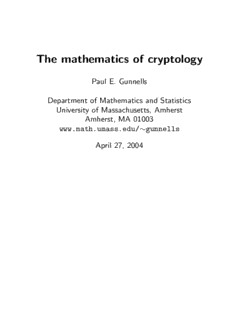
The mathematics of cryptology - University of Massachusetts Amherst PDF
Preview The mathematics of cryptology - University of Massachusetts Amherst
The mathematics of cryptology Paul E. Gunnells Department of Mathematics and Statistics University of Massachusetts, Amherst Amherst, MA 01003 www.math.umass.edu/∼gunnells April 27, 2004 What is Cryptology? • Cryptography is the process of writing using various methods (“ciphers”) to keep messages secret. • Cryptanalysis is the science of attacking ciphers, finding weaknesses, or even proving that a cipher is secure. • Cryptology covers both; it’s the complete science of secure communication. 1 Basic terminology/notation • P is the plaintext. This is the original readable message (written in some standard language, like English, French, Cantonese, Hindi, Icelandic, . . . ). • C is the ciphertext. This is the output of some encryption scheme, and is not readable by humans. • E is the encryption function. We write, for example, E(P) = C to mean that applying the encryption process E to the plaintext P produces the ciphertext C. • D is the decryption function, i.e. D(C) = P. Note D(E(P)) = P and E(D(C)) = C. 2 Basic terminology/notation (cont’d.) • The encryption key is piece of data that allows the computation of E. Similarly we have the decryption key. These may or may not be the same. They also may not be secret, as we’ll see later on. • To attack a cipher is to attempt unauthorized reading of plaintext, or to attempt unauthorized transmission of ciphertext. 3 Shift (aka Cæsar) cipher • Encode letters by numbers: A 7→ 0, B 7→ 1, C 7→ 2, . . . , Z 7→ 25. • Choose a key t, which is a number between 0 and 25 (for Cæsar, t was always 3). • For each letter P, E is defined by E(P) = P + t, i.e. add t to the code for each letter to get a new letter code. If you wind up with a number over 25, loop around to the beginning (like on a clock going past midnight). So, e.g. 25 + 3 = 2. 4 Shift (aka Cæsar) cipher (cont’d.) For example, if we take t = 17, then encrypting the plaintext ALLOFGAULISDIVIDEDINTOTHREEPARTS yields the ciphertext RCCFWXRLCZJUZMZUVUZEKFKYIVVGRIJK • Decryption is done by D(C) = C − t. 5 Remarks • How did Cæsar get to rule the known Western world using this? It’s horrendously insecure. • Variations: ◦ Affine cipher: Choose a number a and define E(P) = aP +t. Must be careful choosing a, e.g. a = 0 not very useful. ◦ Digraph affine cipher: Choose numbers a , a , b , b , t , t , 1 2 1 2 1 2 and then encrypt by transforming pairs of letters: E(P , P ) = (a P +b P +t , a P +b P +t ). 1 2 1 1 1 2 1 2 1 2 2 2 Again the choices must be made carefully. But these schemes are still insecure, since natural languages have statistical biases (the Wheel of Fortune phenomenon). 6 Other uses of cryptography: Protocols Today we use cryptography for a lot more than just sending secret messages. • Authentication. Alice receives ciphertext from Bob. How can she be sure that the message originated from Bob? How can she be sure that the message wasn’t corrupted? How can Bob be sure Alice received it? How can Alice make sure that Bob can’t deny having sent it? • Key exchange. Over an insecure channel, Alice and Bob exchange two pieces of data that allow them to compute a common encryption/decryption key. But any attacker who intercepts the transmissions can’t recover the key. 7 Protocols (cont’d.) • Zero-knowledge proofs. Alice can unequivocally convince Bob that she has a certain piece of information, without revealing the exact piece of information to Bob. • Secret sharing. Alice, Bob, Carol, . . . , Yanni, and Zeke each have a piece of information that is part of a commonly held secret S. ◦ If N or more of them meet and combine their knowledge, then S can be reconstructed. ◦ But if less than N get together, S cannot be reconstructed. All of these protocols are in common usage in computer networks today (ATMs, the Web, . . . ). They are also crucial in sensitive communication between governments. 8 A modicum of mathematics • Integers. Positive and negative counting numbers as well as 0, i.e. {. . . , −2, −1, 0, 1, 2, . . . }. • Prime. A positive integer that is divisible only by 1 and itself, e.g. 2, 3, 5, 7, 11, . . . , 4136658067, . . . . The largest known prime today is 220996011 − 1, and has 6320430 digits. Integers that aren’t prime are called composite. • Factoring. Writing an integer as a product of smaller integers, e.g. 60 = 22 · 3 · 5. • Primality test. A test to decide whether or not an integer is prime. This is not the same as factoring. • Probabilistic primality test. A test to decide whether or not an integer is prime to an (explicitly computable) high probability. Integers that pass these tests are called pseudoprimes, and in applications are just as useful as honest primes. 9
Description: